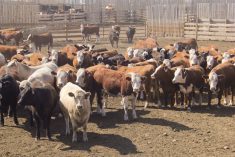There’s a good possibility the Canadian cattle industry will start to shrink if U.S. mandatory country-of-origin labeling (COOL) rules on meat stay in place as they are.
COOL came into effect about five years ago, making it mandatory for retailers to label meat that comes from countries outside of the U.S.
The World Trade Organization said Washington had to change its law to comply with WTO rulings after challenges from Canada and Mexico. Washington on May 23 changed the law, which some argue did not comply with the WTO’s ruling, but that has yet to be determined.
Read Also

U.S. livestock: Feeder cattle hit contract highs on tight supply
Chicago | Reuters – All Chicago Mercantile Exchange feeder cattle futures and most live cattle futures hit contract highs on…
The new rules, in effect since Saturday (Nov. 23), are expected to further increase the cost for Canadian producers over the previous COOL rules, and make the use of Canadian cattle and hogs more difficult for U.S. packers, who now must segregate Canadian-born and -raised livestock.
John Masswohl, director of government and international relations with the Canadian Cattlemen’s Association, said that if COOL stays in the long term, it will likely influence producers in deciding whether to stay in the cattle business or switch to growing grains.
“So over the long term, what this is going to mean is a smaller beef industry, a smaller cattle sector in both Canada and the United States,” he added.
The U.S. cattle industry will also likely feel the effects of the new COOL rule if it stays in place in the long term, because it’s expected to cause some U.S. packers to close up shop.
Masswohl said some packing plants in the U.S. have already stopped processing Canadian cattle, leaving extra space at some of their facilities.
“A company like Tyson operates several facilities around the U.S., and up to this point, Canadian cattle have traditionally been important in four of their facilities. If you take those cattle away, they could basically say which is the facility that relied the most heavily on Canadian cattle?” he said.
“That would be Pasco, Washington, where probably around 30 per cent of the kill was from Canadian cattle,” he said. The Tyson plant at Pasco, about 220 km southwest of Spokane, can process about 2,000 head per day.
“So Tyson could say ‘We get rid of those 30 per cent up in Pasco and we’ve got excess capacity already at the other three — why don’t we just close down Pasco and consolidate everything?'”
That may cause producers in Washington state and surrounding areas to decide to reduce their operations, Masswohl said, because it would take away a close destination to sell their cattle. And if the COOL situation isn’t resolved, such decisions could be made at other companies as well.
“Level field”
But if it is resolved, and the rules are removed, the Canadian cattle industry would likely see great benefits, said Brian Perillat, manager and senior analyst with CanFax.
“That would be huge, it would be very positive if it can get on a level playing field with the U.S.,” he said. “I think we would see our calf prices improve dramatically and help the entire tone to the industry.”
Though prices for all types of Canadian cattle and beef products are generally higher than they were last year, due to lower feed costs and a weaker Canadian dollar, Perillat said there’s still a negative tone to the market because of the COOL situation.
There remains one bright spot for Canadian cattle producers, in the form of Canada’s proposed free trade deal with the European Union.
The deal, if realized, could open up about 65,000 tonnes of new duty-free demand into the European Union, which could amount to $600 million or more in revenue for Canada’s cattle farmers, Masswohl said.
— Terryn Shiells writes for Commodity News Service Canada, a Winnipeg company specializing in grain and commodity market reporting.
Related story:
Canadian feeder cattle exports seen surging after Tyson move, Oct. 25, 2013
















